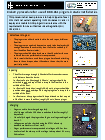Reduce dolphin and porpoise by-catch
Certain vessels must use an acoustic deterrent device, known as a 'pinger', to reduce the level of dolphin and porpoise (cetacean) by-catch.
You must fit and use a device that meets the legal technical requirements and can be used by UK fishing vessels if your vessel is 12 metres or over and use bottom set gill or entangling nets in:
- Area IV and the net’s mesh size is 220mm or more – all year
- Area IV and the net is of any mesh size and is 400 metres or less - all year
- Area VII d, e, f, g, h and j – all year
Map showing areas where the use of acoustic deterrent devices is required under the regulation
You must assess which device is suitable for your purposes and how many you need to be fully compliant. The numbers required and cost of devices will vary depending on the:
- device
- distances it needs to be used at
- length of nets used
The devices must be used as required by the technical specifications and the manufacturer’s guidelines.
To help reduce inspection times and minimise any disruption to your fishing activities, you should record how you use these devices in the comments box on paper log sheets or electronic logs. This should include the:
- make of the device
- numbers used
- spacing of devices along the nets
You should record any by-catch of marine mammals to help the UK with its monitoring and reporting requirements.
Devices
There are many compliant devices and this list is not exhaustive. You should research the different options and choose the device most suitable for your vessel.
| Device | Specifications and spacing |
|---|---|
| Airmar Gillnet Pinger (PDF, 244KB) | Set 2 |
| Aquamark 100 | Set 1 |
| Aquamark 200 | Set 1 |
| Aquamark 300 | Set 2 |
| DDD-03L | |
| FishTek Banana Pinger BP154 | Set 1 |
| Future Oceans 10 KHz Porpoise Pinger | Set 2 |
| [Future Oceans 70 KHz Dolphin Pingerhttp://futureoceans.com/products/) | Set 1 |
| SaveWave HiProtect | Set 1 |
Specifications and spacing
The device used must meet one of the following sets of signal and implementation characteristics or, if it does not, must be separately authorised by the Department of Environment, Food and Rural Affairs (Defra). One device has been separately authorised for use by Defra (DDD-03L)
You must use the DDD-03L as described in the guidance from the Cornish Fish Producers’ Organisation and Sea Mammal Research Unit. For vessels fishing in other MS waters, a letter of authorisation is available from the MMO, which repeats the guidance as to how the DDD-03L must be deployed.
| Set 1 | Set 2 | |
|---|---|---|
| Signal synthesis | Digital | Analogue |
| Tonal/wide band | Wide band or tonal | Tonal |
| Source levels (maximum to minimum) re 1µPa@1m | 145 dB | 130 to 150 dB |
| Fundamental frequency | 20 to 160 kHz wide-band sweeps, 10 kHz tonal | 10 kHz |
| High-frequency harmonics | Yes | Yes |
| Pulse duration (nominal) | 300ms | 300ms |
| Interpulse interval | 4 to 30 seconds randomised, 4 seconds | 4 seconds |
| Maximum spacing between 2 acoustic deterrent devices along a net | 200 metres – 1 device fixed at each end of the net (or combination of nets attached together) | 100 metres – 1 device fixed at each end of the net (or combination of nets attached together) |
Further information
Protecting whales, dolphins and porpoises
Mitigating Cetacean By-catch project which included trials of the DDD-03L
Marine Mammal Bycatch Reporting Requirements
Contact information
Marine Conservation Team
0300 1231032
conservation@marinemanagement.org.uk
MMO Coastal offices
Updates to this page
-
Page guidance updated
-
Updated in line with EU Exit
-
URL https://futureoceans.com/pingers/porpoise-pinger/ added
-
First published.
